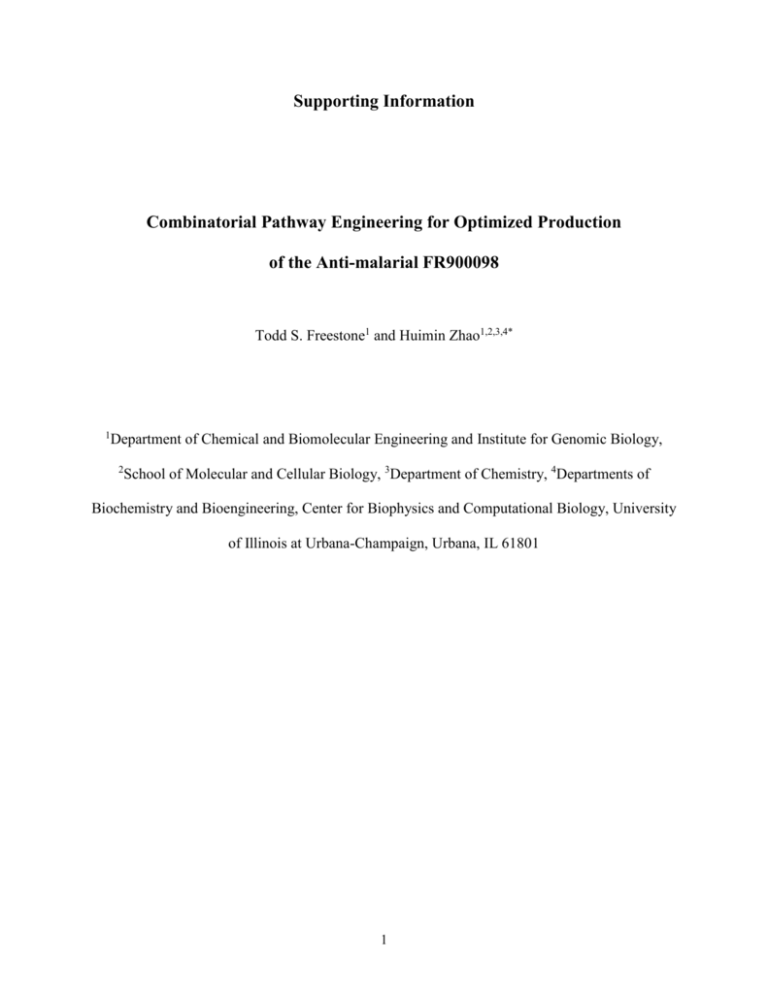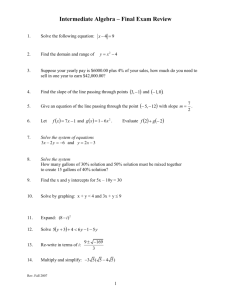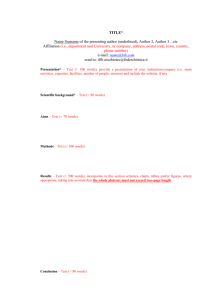bit25719-sup-0001
advertisement

Supporting Information
Combinatorial Pathway Engineering for Optimized Production
of the Anti-malarial FR900098
Todd S. Freestone1 and Huimin Zhao1,2,3,4*
1
Department of Chemical and Biomolecular Engineering and Institute for Genomic Biology,
2
School of Molecular and Cellular Biology, 3Department of Chemistry, 4Departments of
Biochemistry and Bioengineering, Center for Biophysics and Computational Biology, University
of Illinois at Urbana-Champaign, Urbana, IL 61801
1
Supplementary methods
Finding optimal overhangs for Golden Gate assembly. A Perl script was written that used
UNAfold (Markham and Zuker 2008) to calculate the Gibbs free energy of all 256 possible 4base pair overhangs against themselves. Those having a negative free energy against themselves
were screened out as well as those that had a free energy greater than -1 kcal/mol (an arbitrarily
chosen cutoff) when hybridized with their reverse complement, leaving 154 overhangs. The
Gibbs free energy for binding between each of the remaining overhangs was calculated against
all other overhangs and their reverse complements. A set of four overhangs were found, ACAC,
CCCT, TAGC, and TTCG, that gave strong binding to their own reverse complements but not to
themselves, the other overhangs, or the reverse complements of the other overhangs
(Supplementary Table 5).
Knockout of E. coli BL21(DE3) genes. Genes aceE, acs, adhE, atpF, atpH, frdC, ldhA, pflB,
poxB, ppc, pta, and pykF were knocked out using P1 phage recombineering. E. coli BW25113
(Datsenko and Wanner 2000) knockout strains from the Keio collection (Baba et al. 2006) were
used as a source of the mutations, and genomes were compared between this strain and E. coli
BL21(DE3) to ensure that other modifications would be unlikely. To 1 mL of LBCG (LB broth
with 2.5 mM CaCl2 and 0.1% glucose), 5 µL of P1 phage was added. 50 µL of the P1/LBCG
solution was then added to 0.1 mL of LB-grown donor cells in a disposable culture tube and
incubated at room temperature for 10 minutes for phage adsorption. To this solution 2.5 mL
LBCG was added and gently mixed. 2.5 mL of molten LB top agar, cooled to 55 °C, was added
and poured onto a thick (40 mL) LBCG agar plate and placed in a 37 °C incubator. After 4
hours, plates were checked for lysis. If lysis had begun, phages were harvested by adding 5 mL
of ice cold Tris-Phage buffer (10 mM Tris-HCl, 100 mM NaCl, 10 mM MgCl2, 7.2 pH) to each
plate, and plates were left overnight at 4 °C. Buffer was then collected, and a few drops of
chloroform were added, mixed gently, and centrifuged for 10 minutes. Buffer containing phage
was then transferred to a new tube for another round of decontamination by addition of
chloroform. For P1 transduction, a BL21(DE3) colony was grown for 4 hours at 37 °C in 5 mL
LB, and 1 mL of culture was centrifuged for 10 minutes and resuspended in 1 mL MC (10 mM
MgCl2, 4 mM CaCl2) and stood for 5 minutes and then vortexed. 5 µL phage lysate was added to
0.1 mL LB to which 0.1 mL of resuspended cells were added and mixed gently. Cell/phage
mixture stood for 20 minutes, then 1 mL LB with 10 mM ethylene glycol tetraacetic acid
(EGTA) was added and vortexed. Cells were collected by centrifugation, the supernatant was
discarded, and the cells were resuspended in another 1 mL of LB+EGTA. Cells were placed on
a 37 °C shaker for 2 hours and then spread on LB agar plates with 25 µg/mL kanamycin and
incubated at 37 °C for up to 2 days. Colonies were then streaked out on LB + 50 µg/mL
kanamycin plates, and colony PCR was performed to see if the correct deletions were present.
Primers used to check for the deletions are named with the ending “KO-seq-for” and “KO-seqrev”. Knockout strain ackA/pta/adhE was previously constructed (Zha et al. 2009).
2
Enriched library simulations. Simulations were performed using MATLAB (Mathworks,
Natick, MA). For each simulation, a library of 1800 pathways was made where each of nine
genes was assigned a promoter strength, pi, that matched the strengths of our promoter library of
0.03, 0.15, 0.45, and 1. The output for each pathway was then modeled using the equations
outlined below, where the theoretical maximum output is 1. The total product output (PT) of
each pathway is the cellular output (PC) multiplied by a cell mass term (m):
𝑃𝑇 = 𝑚𝑃𝐶
(Equation 1)
Cellular output is determined by the rate-limiting step of the simulated pathway:
𝑃𝐶 = min (𝑘𝑖 𝑝𝑖 )
𝑖=1…8
(Equation 2)
where k represents the turnover rate for enzyme i. Random values between 1 and 10 were
assigned for each k (values 10, 2, 3.5, 1, 3, 1.5, 6, and 4 were assigned to enzymes 1 through 8).
At least one pathway enzyme was assigned a turnover rate of 1 which with the rate-limiting
output would ensure the maximum output did not exceed 1.
The cell mass (also with a maximal possible value of 1) was dependent on the metabolic load
caused by the promoter strengths (L), toxicity of an intermediate (tI), and toxicity of the product
(tP):
𝑚 = (1 − 𝐿 − 𝑡𝐼 )𝑡𝑃
(Equation 3)
The metabolic load was calculated by summing the promoter strengths and dividing it by a
normalization factor (n1, described in more detail below) to ensure that the growth rate will be
positive:
9
1
𝐿 = ∑ 𝑝𝑖
𝑛1
(Equation 4)
𝑖=1
The toxic intermediate was only present if a rate-limiting step upstream of the intermediate (steps
1 through 4) was greater than enzymatic step 5. Another normalization factor was used, again to
ensure a positive growth rate:
0, min (𝑘𝑖 𝑝𝑖 ) ≤ 𝑘5 𝑝5
𝑖=1…4
𝑡𝐼 = { 1
[ min (𝑘 𝑝 )−𝑘5 𝑝5 ], min (𝑘𝑖 𝑝𝑖 ) > 𝑘5 𝑝5
𝑖=1…4
𝑛2 𝑖=1…4 𝑖 𝑖
3
(Equation 5)
Product toxicity was determined by the cellular output as well as the expression of the immunity
enzyme (gene 9):
𝑡𝑃 = {
1 − (𝑃𝐶 − 𝑝9 ),𝑝9 < 𝑃𝐶
1,𝑝9 ≥ 𝑃𝐶
(Equation 6)
According to equation 3, it is possible for the cell mass to be negative if L + tI > 1; however, this
is dependent on the turnover values (k) that the enzymes are assigned. For our mock pathway,
normalization factors of n1 = 12 and n2 =10 were used, giving a maximal value of (L + tI)max =
0.761. These values were chosen to give the metabolic load greater weight (Lmax = 0.75) in
determining cell mass as compared to the toxic intermediate (tI,max = 0.091), which is known to
have low toxicity in the FR900098 pathway. Although these values to an extent are arbitrary, it
should be remembered that the primary purpose of the model is to show the searching
capabilities of the enriched library screening strategy and not to elucidate the actual metabolic
characteristics of the FR900098 pathway.
Supplementary Table I. Primers used in this work.
No.
Primer
Sequence
1
NdeI-FrbA-for
tgacgccatatgcgcgacctgttacgggac
2
FrbA-G1374T-for
gtcccgtcctgggttaagaccagtctggcgccgggctcgc
3
FrbA-G1374T-rev
gcgagcccggcgccagactggtcttaacccaggacgggac
4
FrbA-C1725G-for
gacccggacggcgccgaggtgttcctcgcggacctgtggc
5
FrbA-C1725G-rev
gccacaggtccgcgaggaacacctcggcgccgtccgggtc
6
HindIII-FrbA-rev
tgacctaagctttcaggcctcggcgtcgagcag
7
NdeI-FrbC-for
8
FrbC-C395G-for
9
10
FrbC-C395G-rev
HindIII-FrbCC1077G-rev
tgacgccatatgcgcaacgacttagtgctcg
caaggaccggggcgcgttcgtgtcgatcagcgccgaggac
atc
gatgtcctcggcgctgatcgacacgaacgcgccccggtcc
ttg
tgacctaagctttcaggcggcggccttgttgtagatctcg
acgagctgctcgtgcgacacggcgccgccgatcctgatc
11
HindIII-FrbC-rev
tgacctaagctttcaggcggcggccttgttgtag
12
NdeI-FrbD-for
13
FrbD-G384A-rev
Use
14
FrbD-G468A-for
tgacgccatatgaccaagcgaaccatgttac
cttggccgccgcgagcttggcggcgaagccctcgatcgtt
tcctggtcctgggccccgtc
cttcgccgccaagctcgcggcggccaagaaggcccagcag
accgacgacttcgtggtcgtggcgcggatcgaaaccttca
tcgccg
15
HindIII-FrbD-rev
NdeI-FrbE-A33Tfor
tgacctaagctttcagcgctggagctcgaagacc
tgacgccatatgcgtaaacacacagtcactctgatcgcgg
gtgacggcagcggcccg
HindIII-FrbE-rev
NdeI-FrbG-C45Tfor
tgacctaagctttcatccgatgtcccgcaggcgctcg
tgacgccatatgacgcactacgcgaccgtcatctgcggcg
gtggccccgcgggtgtctccgcggtggtg
16
17
18
4
FrbA mutations
FrbC mutations
FrbD mutations
FrbE mutation
FrbG mutation
19
HindIII-FrbG-rev
tgacctaagctttcaacgcccatcctccgtacgatc
20
NdeI-FrbH-for
21
FrbH-G1773T-rev
22
HindIII-FrbH-rev
23
1A-low-for
24
1A-med-for
25
1A-hi-for
26
1A-WT-for
27
1B-low-for
28
1B-med-for
29
1B-hi-for
30
1B-WT-for
31
1C-low-for
32
1C-med-for
33
1C-hi-for
34
1C-WT-for
35
2A-low-for
36
2A-med-for
37
2A-hi-for
38
2A-WT-for
39
2B-low-for
40
2B-med-for
41
2B-hi-for
42
2B-WT-for
43
2C-low-for
44
2C-med-for
45
2C-hi-for
46
2C-WT-for
tgacgccatatgaacgagaaccggaccttcgccac
gccccgcgggccgccgacgatctcggcgaccgcggcgacc
accacctcgttctccgcgcggctgcggctggagacacgca
ggtaggcgtc
tgacctaagctttcagccgtcggcacggcccgccccctcg
gtcgtcgcggcgccccgcgggccgccgacgatc
cggaagactaacacgtctcaacacgaaattaatacgactc
actaccaccgaattgtgagc
cggaagactaacacgtctcaacacgaaattaatacgactc
actaggtgagaattgtgagc
cggaagactaacacgtctcaacacgaaattaatacgactc
actaaggcggaattgtgagc
cgcctaggaagactaacacgtctcaacacgaaattaatac
gactcactataggggaattg
cggaagactaccctcgaaattaatacgactcactaccacc
gaattgtgagc
cggaagactaccctcgaaattaatacgactcactaggtga
gaattgtgagc
cggaagactaccctcgaaattaatacgactcactaaggcg
gaattgtgagc
cgcctaggaagactaccctcgaaattaatacgactcacta
taggggaattg
cggaagactatagcgaaattaatacgactcactaccaccg
aattgtgagc
cggaagactatagcgaaattaatacgactcactaggtgag
aattgtgagc
cggaagactatagcgaaattaatacgactcactaaggcgg
aattgtgagc
cgcctaggaagactatagcgaaattaatacgactcactat
aggggaattg
cgggtctcaacacgtctcaccctcgaaattaatacgactc
actaccaccgaattgtgagc
cgggtctcaacacgtctcaccctcgaaattaatacgactc
actaggtgagaattgtgagc
cgggtctcaacacgtctcaccctcgaaattaatacgactc
actaaggcggaattgtgagc
cgcctaggtctcaacacgtctcaccctcgaaattaatacg
actcactataggggaattg
cgggtctcaccctgcgaaattaatacgactcactaccacc
gaattgtgagc
cgggtctcaccctgcgaaattaatacgactcactaggtga
gaattgtgagc
cgggtctcaccctgcgaaattaatacgactcactaaggcg
gaattgtgagc
cgcctaggtctcaccctgcgaaattaatacgactcactat
aggggaattg
cgggtctcatagcgaaattaatacgactcactaccaccga
attgtgagc
cgggtctcatagcgaaattaatacgactcactaggtgaga
attgtgagc
cgggtctcatagcgaaattaatacgactcactaaggcgga
attgtgagc
cgcctaggtctcatagcgaaattaatacgactcactatag
gggaattg
5
FrbG mutation
FrbH mutation
Pathway assembly
47
3A-low-for
48
3A-med-for
49
3A-hi-for
50
3A-WT-for
51
1A-rev
52
1B-rev
53
1C-rev
54
2A-rev
55
2B-rev
56
2C-rev
57
3C-rev
58
BB-I-for
59
BB-I-rev
60
BB-II/III-for
cgggtctcaacacgtctcatagcgaaattaatacgactca
ctaccaccgaattgtgagc
cgggtctcaacacgtctcatagcgaaattaatacgactca
ctaggtgagaattgtgagc
cgggtctcaacacgtctcatagcgaaattaatacgactca
ctaaggcggaattgtgagc
cgcctaggtctcaacacgtctcatagcgaaattaatacga
ctcactataggggaattg
cttgaggaagactaagggctcctttcagcaaaaaacccct
caag
cttgaggaagactagctactcctttcagcaaaaaacccct
caag
cttgaggaagactacgaacgtctcaagggctcctttcagc
aaaaaacccctcaag
cttgagggtctcaagggctcctttcagcaaaaaacccctc
aag
cttgagggtctcagctactcctttcagcaaaaaacccctc
aag
cttgagggtctcacgaacgtctcagctactcctttcagca
aaaaacccctcaag
cttgagggtctcacgaacgtctcacgaactcctttcagca
aaaaacccctcaag
tgactcgaagactattcgcaataaaccggtaaaccagcaa
tagac
cttgaggaagactagtgtcgaccgatgcccttgagagcct
tcaac
tgactcggtctcattcgcaataaaccggtaaaccagcaat
agac
cttgagggtctcagtgtcgaccgatgcccttgagagcctt
caac
tgactcggtctcacccttatgcgacacacagagacgtcag
ccgctacagggcgcgtccc
tgactcggtctcacaagcgaatgagacgaccggtggaaag
cgggcagtgag
61
BB-II/III-rev
62
GGBB-lacZa-for
63
GGBB-lacZa-rev
64
GGBB-pET-1-for
tgactcggtctcacttgccagcgccctagcgcccgc
65
GGBB-pET-1-rev
66
GGBB-pET-2-for
tgactcggtctcatagccgcggtatcattgcagcactgg
tgactcggtctcagctaccacgctcaccggctccagattt
atcag
67
tgactcggtctcacgaaaactcacgttaagggattttg
ctcggtctcattcgttccactgagcgtcagaccccgtaga
aacgtaacggcaaaagcacc
71
GGBB-pET-2-rev
GGBB-pACYC-1for
GGBB-pACYC-1rev
GGBB-pACYC-2for
GGBB-pACYC-2rev
72
T7-WT-for-check
cccgcgaaattaatacgactcactata
73
T7-hi-for-check
cccgcgaaattaatacgactcactaggtga
74
T7-med-for-check
cccgcgaaattaatacgactcactaaggc
75
T7-low-for-check
cccgcgaaattaatacgactcactaccacc
68
69
70
Pathway assembly
pFRGG1 backbone
pFRGG2/3 backbone
pFRGG-BB assembly
tgactcggtctcagtgtcactggtgaaaagaaaaacc
tgactcggtctcaacacgggcaacagctgattgcc
tgactcggtctcaagggagagcgtcgagatcccgg
6
PCR assay for
promoter assignments
76
FrbA-prom-seq-rev
gttcgtactcacggcgcatg
77
FrbB-prom-seq-rev
acgaactcggaaacccggtc
78
FrbC-prom-seq-rev
tggcactgcacgtcgatgtc
79
FrbD-prom-seq-rev
gagttgcgcttcgggaagac
80
FrbE-prom-seq-rev
tgatcggcttcagcgagaagg
81
FrbF-prom-seq-rev
gagaacgtcggcatgaccag
82
FrbG-prom-seq-rev
agtagaagatcggcggcagc
83
FrbH-prom-seq-rev
tcggaggttgttggtcgtcg
84
DxrB-prom-seq-rev
85
T7-mut-3N
86
T7-mut-6N
ccttgttcgccaggatgagc
cgtagcatgccgaaattaatacgactcactaNaNgNgaat
tgtgagcggataacaattc
cgtagcatgccgaaattaatacgactcactNNNNNNgaat
tgtgagcggataacaattc
87
XhoI-GFP-rev
88
T7-low-for
89
T7-med-for
90
T7-hi-for
cacgtactcgagtcatttgtatagttcatccatg
cgtagcatgccgaaattaatacgactcactaccaccgaat
tgtgagcggataacaattc
cgtagcatgccgaaattaatacgactcactaggtgagaat
tgtgagcggataacaattc
cgtagcatgccgaaattaatacgactcactaaggcggaat
tgtgagcggataacaattc
91
aceE KO seq for
cgcatcgccatctggcctttatcg
92
aceE KO seq rev
caactttgtcgcccactttgaccagg
93
acs KO seq for
cccgctcccttatgggagaagg
94
acs KO seq rev
caacagcatgcataactgcatgttcctc
95
adhE KO seq for
gcatgagcagaaagcgtcaggc
96
adhE KO seq rev
cgccacctggaagtgacgc
97
atpF KO seq for
cgactcggcgagcgtttctgg
98
atpF KO seq rev
tcccgatgatcgctgtaggtctgg
99
atpH KO seq for
cccggcagggagatcatttcacc
100
atpH KO seq rev
gcagattctggacgaagcgaaagctg
101
frdC KO seq for
ccaatgaagctctgcgcgaacg
102
frdC KO seq rev
ccacggtaagaaggagcgtatggc
103
ldhA KO seq for
tgctgtagctgttctggcgtaacagc
104
ldhA KO seq rev
ccgagcgtcatcagcagcg
105
pflB KO seq for
attgcggtgtttctccagatgtggcc
106
pflB KO seq rev
tattgtaatccgcgacttcgcatccccg
107
poxB KO seq for
gcctgagtgccggtaggcag
108
poxB KO seq rev
cgtaccgtgatgacctgcggc
109
ppc KO seq for
ccaacccagggctttccagc
110
ppc KO seq rev
cgcatcttatccgacctacacctttgg
111
pta KO seq for
cctggctgcacgtttcggc
112
pta KO seq rev
ggaactacccaggtggcaaggc
113
pykF KO seq for
cagcgtataatgcgcgccaattgac
114
pykF KO seq rev
gttcgctcaaagaagcatcgaacgc
7
PCR assay for
promoter assignments
T7 promoter library
generation
Reconstruct chosen
T7 promoter mutants
To check for correct
gene knockouts
Supplementary Table II. Mutations made in FR900098 biosynthetic genes for Golden Gate
compatibility.
Gene
Mutation 1
RE site
Mutation 2
RE site
frbA
frbC
frbD
frbE
frbG
frbH
1374G>T
396C>G
384G>A
33A>T
45C>T
1775G>T
BbsI
Esp3I
Esp3I
Esp3I
Esp3I
BsaI
1735C>G
1077C>G
468G>A
BbsI
Esp3I
BsaI
Supplementary Table III. PCR and OE-PCR for the introduction of mutations in FR900098
biosynthetic genes.
Gene
frbA
Template
pET26b-frbA
pET26b-frbA
pET26b-frbA
A6
pET26b-frbC
pET26b-frbC
C3
pET26b-frbC
pET26b-frbC
D3
pET26b-frbE
Forward primer/fragment
NdeI.FrbA for
FrbA G1374T for
FrbA C1725G for
A1
A2
A4
NdeI.FrbA for
NdeI.FrbC for
FrbC C395G for
C1
NdeI.FrbC for
NdeI.FrbD for
FrbD G468A for
D1
NdeI.FrbD for
frbE
Fragment
A1
A2
A3
A4
A5
A6
A7
C1
C2
C3
C4
D1
D2
D3
D4
E1
frbG
G1
pET26b-frbG
frbH
H1
H2
pET26b-frbH
H1
NdeI.FrbG C45T for
NdeI.FrbH for
NdeI.FrbH for
frbC
frbD
NdeI.FrbE A33T for
8
Reverse primer/ fragment
FrbA G1374T rev
FrbA C1725G rev
HindIII.FrbA rev
A2
A3
A5
HindIII.FrbA rev
FrbC C395G rev
HindIII.FrbC C1077G rev
C2
HindIII.FrbC rev
FrbD G384A rev
HindIII.FrbD rev
D2
HindIII.FrbD rev
HindIII.FrbE rev
Method
PCR
PCR
PCR
OE-PCR
OE-PCR
OE-PCR
PCR
PCR
PCR
OE-PCR
PCR
PCR
PCR
OE-PCR
PCR
PCR
HindIII.FrbG rev
PCR
FrbH G1773T rev
HindIII.FrbH rev
PCR
PCR
Supplementary Table IV.
combinatorial pathway.
Fragment
Template
frbA-lo
frbA-med
frbA-hi
frbA-WT
frbB-lo
frbB-med
frbB-hi
frbB-WT
frbC-lo
frbC-med
frbC-hi
frbC-WT
frbD-lo
frbD-med
frbD-hi
frbD-WT
frbE-lo
frbE-med
frbE-hi
frbE-WT
pFRGG-A
pFRGG-A
pFRGG-A
pFRGG-A
pET26b-frbB
pET26b-frbB
pET26b-frbB
pET26b-frbB
pFRGG-C
pFRGG-C
pFRGG-C
pFRGG-C
pFRGG-D
pFRGG-D
pFRGG-D
pFRGG-D
pFRGG-E
pFRGG-E
pFRGG-E
pFRGG-E
PCR reactions for fragments used to construct the FR900098
Forward
primer
1A low for
1A med for
1A hi for
1A WT for
1B low for
1B med for
1B hi for
1B WT for
2A low for
2A med for
2A hi for
2A WT for
2B low for
2B med for
2B hi for
2B WT for
2C low for
2C med for
2C hi for
2C WT for
Reverse
primer
1A rev
1A rev
1A rev
1A rev
1B rev
1B rev
1B rev
1B rev
2A rev
2A rev
2A rev
2A rev
2B rev
2B rev
2B rev
2B rev
2C rev
2C rev
2C rev
2C rev
Fragment
Template
frbF-lo
frbF-med
frbF-hi
frbF-WT
frbG-lo
frbG-med
frbG-hi
frbG-WT
frbH-lo
frbH-med
frbH-hi
frbH-WT
dxrB-lo
dxrB-med
dxrB-hi
dxrB-WT
BB-I
BB-II/III
pET26b-frbF
pET26b-frbF
pET26b-frbF
pET26b-frbF
pFRGG-G
pFRGG-G
pFRGG-G
pFRGG-G
pFRGG-H
pFRGG-H
pFRGG-H
pFRGG-H
pET26b-dxrB
pET26b-dxrB
pET26b-dxrB
pET26b-dxrB
pACYCDuet-1
pACYCDuet-1
Forward
primer
3A low for
3A med for
3A hi for
3A WT for
1C low for
1C med for
1C hi for
1C WT for
2B low for
2B med for
2B hi for
2B WT for
2C low for
2C med for
2C hi for
2C WT for
BB-I for
BB-II/III for
Supplementary Table V. PCR reactions for the construction of pFRGG-BB.
Fragment
GGBB lacZα
GGBB pET 1
GGBB pET 2
GGBB pACYC 1
GGBB pACYC 2
Template
lacZα
pETDuet-1
pETDuet-1
pACYCDuet-1
pACYCDuet-2
Forward primer
GGBB lacZa for
GGBB pET 1 for
GGBB pET 2 for
GGBB pACYC 1 for
GGBB pACYC 2 for
9
Reverse primer
GGBB lacZa rev
GGBB pET 1 rev
GGBB pET 2 rev
GGBB pACYC 1 rev
GGBB pACYC 2 rev
Reverse
primer
2A rev
2A rev
2A rev
2A rev
1C rev
1C rev
1C rev
1C rev
2B rev
2B rev
2B rev
2B rev
3C rev
3C rev
3C rev
3C rev
BB-I rev
BB-II/III rev
Supplementary Table VI. Gibbs free energy (kcal/mol) between the four chosen overhangs
(ACAC, CCCT, TAGC, TTCG). Dark green denotes strong binding. Maximum calculation for
free energy is 5 kcal/mol, which has been listed for combinations with no binding.
Overhangs
Forward sequences
ACAC CCCT TAGC
TTCG
Reverse complements
GTGT
AGGG
GCTA
CGAA
ACAC
5
5
5
5
-2.32
5
5
5
CCCT
5
5
0.61
5
5
-4.05
5
5
TAGC
5 0.61 0.003 1.859
5
5
-2.762
5
TTCG
5
5
5
5
-2.511
5 1.859 1.569
10
Supplementary Figure 1. Number of screens necessary for 1x coverage of a combinatorial
pathway library depending on library size compared and screening rate. Numbers in blue circles
represent pathways studied in the references below the table. The star represents this study.
1.
2.
3.
4.
Wu, J. J., Du, G. C., Zhou, J. W., and Chen, J. 2013. Metabolic engineering of Escherichia coli
for (2S)-pinocembrin production from glucose by a modular metabolic strategy. Metab Eng 16:
48-55.
Ajikumar, P. K., Xiao, W. H., Tyo, K. E. J., Wang, Y., Simeon, F., Leonard, E., Mucha, O.,
Phon, T. H., Pfeifer, B., and Stephanopoulos, G. 2010. Isoprenoid pathway optimization for taxol
precursor overproduction in Escherichia coli. Science 330:70-74.
Du, J., Yuan, Y. B., Si, T., Lian, J. Z., and Zhao, H. M. 2012. Customized optimization of
metabolic pathways by combinatorial transcriptional engineering. Nucleic Acids Res 40, e142.
Latimer, L. N., Lee, M. E., Medina-Cleghorn, D., Kohnz, R. A., Nomura, D. K., and Dueber, J. E.
2014. Employing a combinatorial expression approach to characterize xylose utilization in
Saccharomyces cerevisiae. Metab Eng 25:20-29.
11
Supplementary Figure 2. Promoter strengths of a chosen library. Originals promoters screened
in at least quadruplicates, and reconstructed promoters in duplicates except for the High
promoter, which only had one sample.
Fluorescence (au)
10000
1000
100
Original
Reconstructed
10
1
Low
Weak
High
Promoter
12
WT
Supplementary Figure 3. (A) Feeding assay of various amounts of supernatant from all WT T7
promoter strain fed to 120 µL culture of the phosphonate uptake strain WM6242. Each point
shows average of 48 culture wells (half of 96-well plate), with error bars showing the minimum
and maximum OD 600 measured for each supernatant volume fed. Although the assay is not
quantitative, it can show whether the concentration is above a certain threshold. (B-D) OD600
measured of WM6242 cultures fed supernatants from strains of each round of screening.
Samples are ordered from strongest to weakest growth inhibition, with hits carried over for direct
LC-MS quantification highlighted in red. Z-factors for the random library (B), first enriched
library (C), and second enriched library (D) are 0.253, 0.383, and -0.250, and were calculated by
using the hits as controls and non-hits as background (Zhang et al. 1999). The negative Z-factor
for the second enriched library is due to all hits being along the upper half of the dynamic range,
giving them a high average and large standard deviation.
1.2
A.
1
OD 600
0.8
0.6
0.4
0.2
0
0.01
0.1
1
10
Production supernatant fed (µl)
B.
OD 600
Random library growth inhibition of WM6242
1
0.9
0.8
0.7
0.6
0.5
0.4
0.3
0.2
0.1
0
Non-hits
Hits
0
500
1000
1500
Sample
13
2000
2500
C.
First enriched library growth inhibition of WM6242
1.4
1.2
OD 600
1
0.8
0.6
Non-hits
0.4
Hits
0.2
0
0
500
1000
1500
2000
2500
Sample
D.
Second enriched library growth inhibition of WM6242
1.4
1.2
OD 600
1
0.8
0.6
Non-hits
0.4
Hits
0.2
0
0
500
1000
1500
Sample
14
2000
2500
Supplementary Figure 4. Production of top strains from each round that were tested as 5 mL cultures.
Error bars show the standard deviation of duplicates. Below the chart, a table of the promoter assignments
is given of each round’s top pathway (boldfaced) as well an additional three strains from the 2nd enriched
library.
Relative FR900098 production
6
5
4
All WT T7 promoters
3
Random library
1st enriched library
2
2nd enriched library
1
0
4pT
4pTR
4pTRA
4pTRB
4pTRN
4pTRQ
FrbD
Med
Low
Low
Low
Low
Low
FrbC
High
High
High
High
High
High
FrbA
Med
High
High
FrbB
Low
Low
Med
Med
High
Med
Low
Low
Low
15
FrbE
Low
Low
Low
Low
Low
FrbH
Low
Low
Low
Low
Low
FrbG
High
High
High
High
High
FrbF
Med
High
High
High
High
DxrB
High
High
Low
High
Low
Low
Low
High
High
High
Supplementary Figure 5. Gene knockout effects on FR900098 output in strain 4pTR.
FR900098 (mg/L)
120
100
80
60
40
20
0
Knockout strains
References
Baba T, Ara T, Hasegawa M, Takai Y, Okumura Y, Baba M, Datsenko KA, Tomita M, Wanner
BL, Mori H. 2006. Construction of Escherichia coli K-12 in-frame, single-gene knockout
mutants: the Keio collection. Mol Syst Biol 2.
Datsenko KA, Wanner BL. 2000. One-step inactivation of chromosomal genes in Escherichia
coli K-12 using PCR products. P Natl Acad Sci USA 97:6640-6645.
Markham NR, Zuker M. 2008. UNAFold: software for nucleic acid folding and hybridization.
Methods Mol Biol 453:3-31.
Zha WJ, Rubin-Pitel SB, Shao ZY, Zhao HM. 2009. Improving cellular malonyl-CoA level in
Escherichia coli via metabolic engineering. Metab Eng 11:192-198.
Zhang JH, Chung TDY, Oldenburg KR. 1999. A simple statistical parameter for use in
evaluation and validation of high throughput screening assays. J Biomol Screen 4:67-73.
16







